編輯:關於Android編程
Android網絡編程之傳遞數據給服務器(一)
請尊重他人的勞動成果,轉載請注明出處:Android網絡編程之傳遞數據給服務器(一)
因為Android程序需要和服務器進行通信,所以需要服務器端提供的支持。
通過GET方式上傳數據主要適用於數據大小不超過2KB,且對安全性要求不高的情況下。
服務器端項目結構:
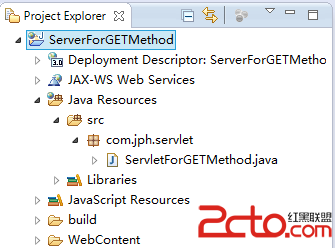
package com.jph.sgm.servlet;
import java.io.IOException;
import javax.servlet.ServletException;
import javax.servlet.annotation.WebServlet;
import javax.servlet.http.HttpServlet;
import javax.servlet.http.HttpServletRequest;
import javax.servlet.http.HttpServletResponse;
/**
* Servlet implementation class ServletForGETMethod
*/
@WebServlet("/ServletForGETMethod")
public class ServletForGETMethod extends HttpServlet {
private static final long serialVersionUID = 1L;
/**
* @see HttpServlet#HttpServlet()
*/
public ServletForGETMethod() {
super();
// TODO Auto-generated constructor stub
}
/**
* @see HttpServlet#doGet(HttpServletRequest request, HttpServletResponse response)
*/
protected void doGet(HttpServletRequest request, HttpServletResponse response) throws ServletException, IOException {
// TODO Auto-generated method stub
//獲取請求的參數(使用utf-8進行解碼,然後用進行ISO8859-1編碼)
// String name=new String(request.getParameter("name").getBytes("ISO8859-1"),"utf-8");
String name=request.getParameter("name");
String pwd=request.getParameter("pwd");
System.out.println("name:"+name+" pwd:"+pwd);
}
/**
* @see HttpServlet#doPost(HttpServletRequest request, HttpServletResponse response)
*/
protected void doPost(HttpServletRequest request, HttpServletResponse response) throws ServletException, IOException {
// TODO Auto-generated method stub
}
}
發布項目並在浏覽器中輸入:http://localhost:8080/ServerForGETMethod/ServletForGETMethod?name=aa&pwd=124
可以再控制台看到如下圖的輸出:

至此服務器端項目已經完成。下面開始創建Android端項目。
Android端項目結構:
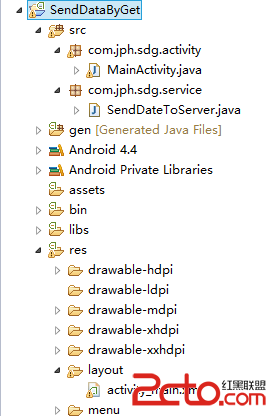
核心代碼:SendDateToServer.java:
package com.jph.sdg.service;
import java.net.HttpURLConnection;
import java.net.URL;
import java.net.URLEncoder;
import java.util.HashMap;
import java.util.Map;
import android.os.Handler;
/**
* 通過GET方式向服務器發送數據
* @author jph
* Date:2014.09.27
*/
public class SendDateToServer {
private static String url="http://10.219.61.117:8080/ServerForGETMethod/ServletForGETMethod";
public static final int SEND_SUCCESS=0x123;
public static final int SEND_FAIL=0x124;
private Handler handler;
public SendDateToServer(Handler handler) {
// TODO Auto-generated constructor stub
this.handler=handler;
}
/**
* 通過Get方式向服務器發送數據
* @param name 用戶名
* @param pwd 密碼
*/
public void SendDataToServer(String name,String pwd) {
// TODO Auto-generated method stub
final Mapmap=new HashMap();
map.put("name", name);
map.put("pwd", pwd);
new Thread(new Runnable() {
@Override
public void run() {
// TODO Auto-generated method stub
try {
if (sendGetRequest(map,url,"utf-8")) {
handler.sendEmptyMessage(SEND_SUCCESS);//通知主線程數據發送成功
}else {
//將數據發送給服務器失敗
}
} catch (Exception e) {
// TODO Auto-generated catch block
e.printStackTrace();
}
}
}).start();
}
/**
* 發送GET請求
* @param map 請求參數
* @param url 請求路徑
* @return
* @throws Exception
*/
private boolean sendGetRequest(Map param, String url,String encoding) throws Exception {
// TODO Auto-generated method stub
//http://localhost:8080/ServerForGETMethod/ServletForGETMethod?name=aa&pwd=124
StringBuffer sb=new StringBuffer(url);
if (!url.equals("")&!param.isEmpty()) {
sb.append("?");
for (Map.Entryentry:param.entrySet()) {
sb.append(entry.getKey()+"=");
sb.append(URLEncoder.encode(entry.getValue(), encoding));
sb.append("&");
}
sb.deleteCharAt(sb.length()-1);//刪除字符串最後 一個字符“&”
}
HttpURLConnection conn=(HttpURLConnection) new URL(sb.toString()).openConnection();
conn.setConnectTimeout(5000);
conn.setRequestMethod("GET");//設置請求方式為GET
if (conn.getResponseCode()==200) {
return true;
}
return false;
}
}
package com.jph.sdg.activity;
import com.jph.sdg.R;
import com.jph.sdg.service.SendDateToServer;
import android.os.Bundle;
import android.os.Handler;
import android.os.Message;
import android.app.Activity;
import android.view.View;
import android.view.View.OnClickListener;
import android.widget.Button;
import android.widget.EditText;
import android.widget.Toast;
/**
* 通過GET方式向服務器發送數據,通過GET方式上傳數據主要適用於數
* 據大小不超過2KB,且對安全性要求不高的情況下。
* @author jph
* Date:2014.09.27
*/
public class MainActivity extends Activity {
private EditText edtName,edtPwd;
private Button btnSend;
Handler handler=new Handler(){
public void handleMessage(Message msg) {
switch (msg.what) {
case SendDateToServer.SEND_SUCCESS:
Toast.makeText(MainActivity.this, "登陸成功", Toast.LENGTH_SHORT).show();
break;
case SendDateToServer.SEND_FAIL:
Toast.makeText(MainActivity.this, "登陸失敗", Toast.LENGTH_SHORT).show();
break;
default:
break;
}
};
};
@Override
protected void onCreate(Bundle savedInstanceState) {
super.onCreate(savedInstanceState);
setContentView(R.layout.activity_main);
edtName=(EditText)findViewById(R.id.edtName);
edtPwd=(EditText)findViewById(R.id.edtPwd);
btnSend=(Button)findViewById(R.id.btnSend);
btnSend.setOnClickListener(new OnClickListener() {
@Override
public void onClick(View v) {
// TODO Auto-generated method stub
String name=edtName.getText().toString();
String pwd=edtPwd.getText().toString();
if (edtName.equals("")||edtPwd.equals("")) {
Toast.makeText(MainActivity.this, "用戶名或密碼不能為空", Toast.LENGTH_LONG).show();
}else {
new SendDateToServer(handler).SendDataToServer(name, pwd);
}
}
});
}
}
至此Android端項目已經完成了。下面就讓我們看一下APP運行效果吧:
Android運行效果圖:
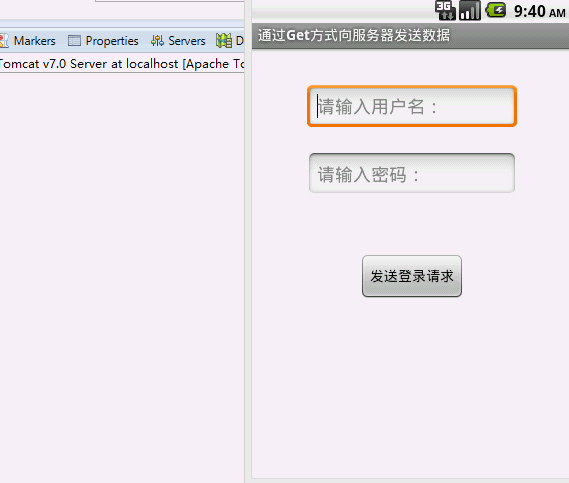 2
2
當客戶端向服務器發送中文時服務器端會出現亂碼現象,如下圖:
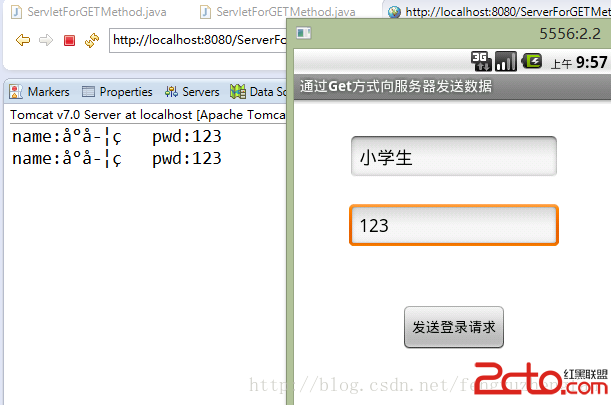 vcq9tKu13cr9vt24+Lf+zvHG98qxo6zW0M7EwtLC67XEveK+9re9sLg=">
vcq9tKu13cr9vt24+Lf+zvHG98qxo6zW0M7EwtLC67XEveK+9re9sLg=">
出現亂碼的原因主要是,Android客戶端我們采用的是UTF-8編碼,而Tomcat默認采用的是ISO8858-1編碼,所以會出現中文亂碼的現象。
解決方案有兩種:
是使用UTF-8解碼請求參數得到漢字,然後再通過ISO8859-1進行編碼。此時服務器端的Servlet是:
package com.jph.sgm.servlet;
import java.io.IOException;
import javax.servlet.ServletException;
import javax.servlet.annotation.WebServlet;
import javax.servlet.http.HttpServlet;
import javax.servlet.http.HttpServletRequest;
import javax.servlet.http.HttpServletResponse;
/**
* Servlet implementation class ServletForGETMethod
*/
@WebServlet("/ServletForGETMethod")
public class ServletForGETMethod extends HttpServlet {
private static final long serialVersionUID = 1L;
/**
* @see HttpServlet#HttpServlet()
*/
public ServletForGETMethod() {
super();
// TODO Auto-generated constructor stub
}
/**
* @see HttpServlet#doGet(HttpServletRequest request, HttpServletResponse response)
*/
protected void doGet(HttpServletRequest request, HttpServletResponse response) throws ServletException, IOException {
// TODO Auto-generated method stub
//獲取請求的參數(使用utf-8進行解碼,然後用進行ISO8859-1編碼)
String name=new String(request.getParameter("name").getBytes("ISO8859-1"),"utf-8");
// String name=request.getParameter("name");
String pwd=request.getParameter("pwd");
System.out.println("name:"+name+" pwd:"+pwd);
}
/**
* @see HttpServlet#doPost(HttpServletRequest request, HttpServletResponse response)
*/
protected void doPost(HttpServletRequest request, HttpServletResponse response) throws ServletException, IOException {
// TODO Auto-generated method stub
}
}
運行結果如下圖:
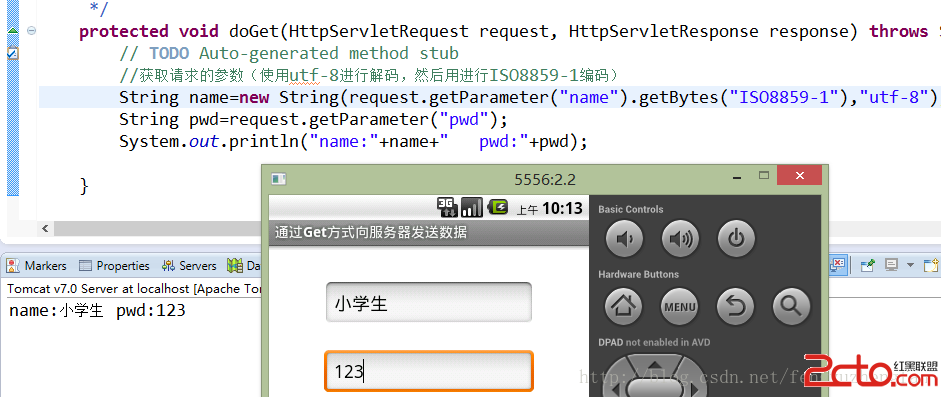
下面我們采用過濾器的方式來解決亂碼的問題:
第一步:建立一個Filter過濾器。
EncodingFilter.java
package com.jph.sgm.filter;
import java.io.IOException;
import javax.servlet.Filter;
import javax.servlet.FilterChain;
import javax.servlet.FilterConfig;
import javax.servlet.ServletException;
import javax.servlet.ServletRequest;
import javax.servlet.ServletResponse;
import javax.servlet.annotation.WebFilter;
import javax.servlet.http.HttpServletRequest;
/**
* Servlet Filter implementation class EncodingFilter
*/
@WebFilter("/*")
public class EncodingFilter implements Filter {
/**
* Default constructor.
*/
public EncodingFilter() {
// TODO Auto-generated constructor stub
}
/**
* @see Filter#destroy()
*/
public void destroy() {
// TODO Auto-generated method stub
}
/**
* @see Filter#doFilter(ServletRequest, ServletResponse, FilterChain)
*/
public void doFilter(ServletRequest request, ServletResponse response, FilterChain chain) throws IOException, ServletException {
// TODO Auto-generated method stub
HttpServletRequest req=(HttpServletRequest) request;
if ("GET".equals(req.getMethod())) {
HttpServletRequestEncodingWrapper wrapper=new HttpServletRequestEncodingWrapper(req);
chain.doFilter(wrapper, response);
}else {
req.setCharacterEncoding("utf-8");
chain.doFilter(request, response);
}
}
/**
* @see Filter#init(FilterConfig)
*/
public void init(FilterConfig fConfig) throws ServletException {
// TODO Auto-generated method stub
}
}
上面的過濾器因為設置了過濾路徑為*/所以會過濾所有的Servlet。
在上面的過濾器中用到了一個包裝器,HttpServletRequestEncodingWrapper.java
package com.jph.sgm.filter;
import java.io.UnsupportedEncodingException;
import javax.servlet.http.HttpServletRequest;
import javax.servlet.http.HttpServletRequestWrapper;
public class HttpServletRequestEncodingWrapper extends
HttpServletRequestWrapper {
private HttpServletRequest request;
public HttpServletRequestEncodingWrapper(HttpServletRequest request) {
// TODO Auto-generated constructor stub
super(request);
this.request=request;
}
@Override
public String getParameter(String name) {
// TODO Auto-generated method stub
String value=request.getParameter(name);
if (value!=null) {
try {//用utf-8進行解碼,然後用ISO8859-1進行編碼
return new String(value.getBytes("ISO8859-1"),"utf-8");
} catch (UnsupportedEncodingException e) {
// TODO Auto-generated catch block
e.printStackTrace();
}
}
return super.getParameter(name);
}
}
重新運行項目可以看到服務器會將客戶端發來的數據用UTF-8進行解碼,用ISO8859-1進行編碼。運行效果圖如下:
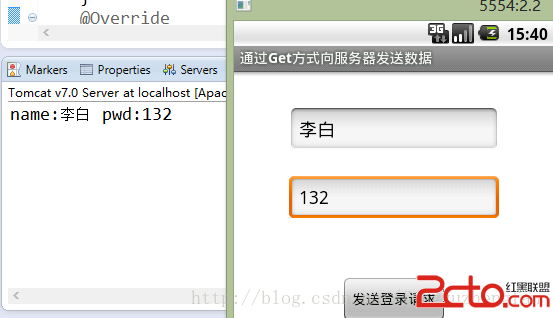
Android網絡編程之傳遞數據給服務器(二)——通過POST的方式將數據傳遞給服務器
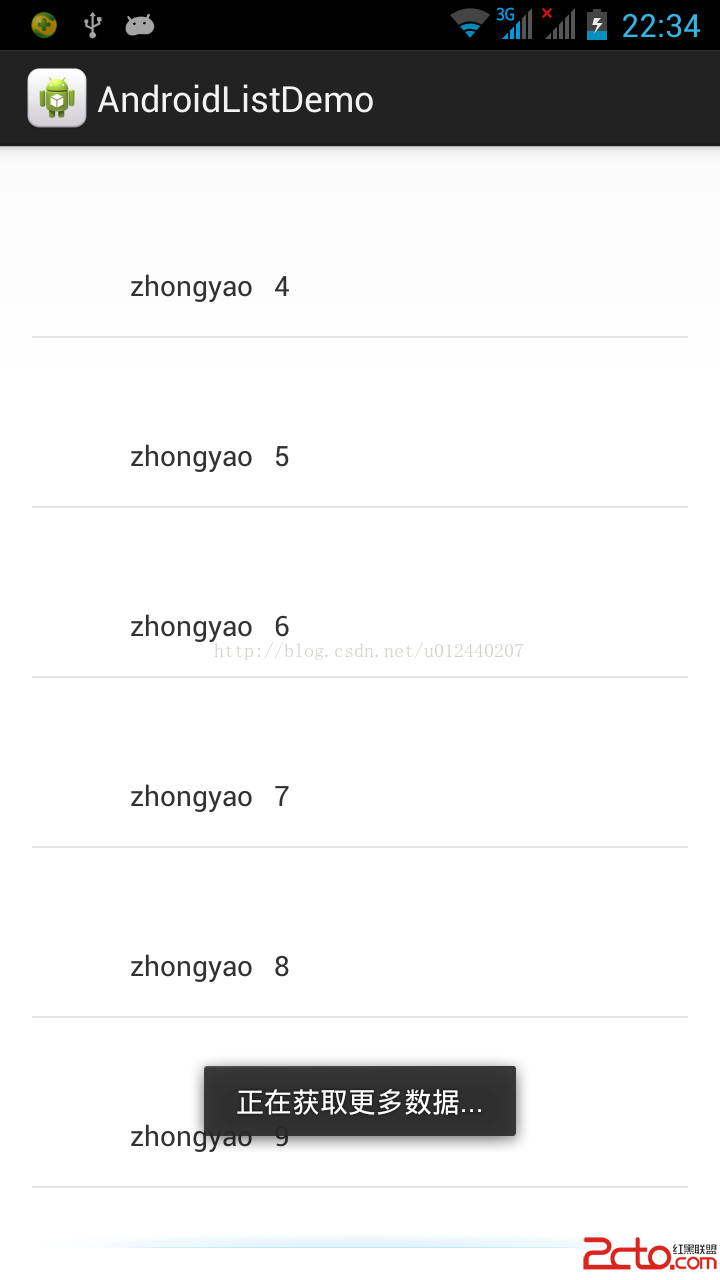 Android listView的上拉刷新(加載更多)
Android listView的上拉刷新(加載更多)
以前也實現過,ListView的上拉刷新,不過用的是開源代碼,由於本人比較懶吧,源碼也沒怎麼研究,所以現在寫出來還不是那麼流利。還好本人發現了自己的這些特點,所以寫出來個
 Android自定義控件實現底部菜單(上)
Android自定義控件實現底部菜單(上)
今天我們封裝一個底部的菜單欄,這個大多數的應用都會用到,因此我們來自定義,方便以後項目的使用。該控件的實現將分上下篇來介紹,先來看一個菜單欄的子控件–MenuItemM,
 Android Studio 1.4帶來的福利
Android Studio 1.4帶來的福利
前一段時間更新了Android Studio,目前最新的穩定版是1.4。更新之後沒看到什麼大的變化。今天去逛官方的更新日志,發現1.4版本著實增加了不少使用的
 安卓動態調試七種武器之長生劍 - Smali Instrumentation
安卓動態調試七種武器之長生劍 - Smali Instrumentation
0x00 序隨著移動安全越來越火,各種調試工具也都層出不窮,但因為環境和需求的不同,並沒有工具是萬能的。另外工具是死的,人是活的,如果能搞懂工具的原理再結合上自身的經驗,